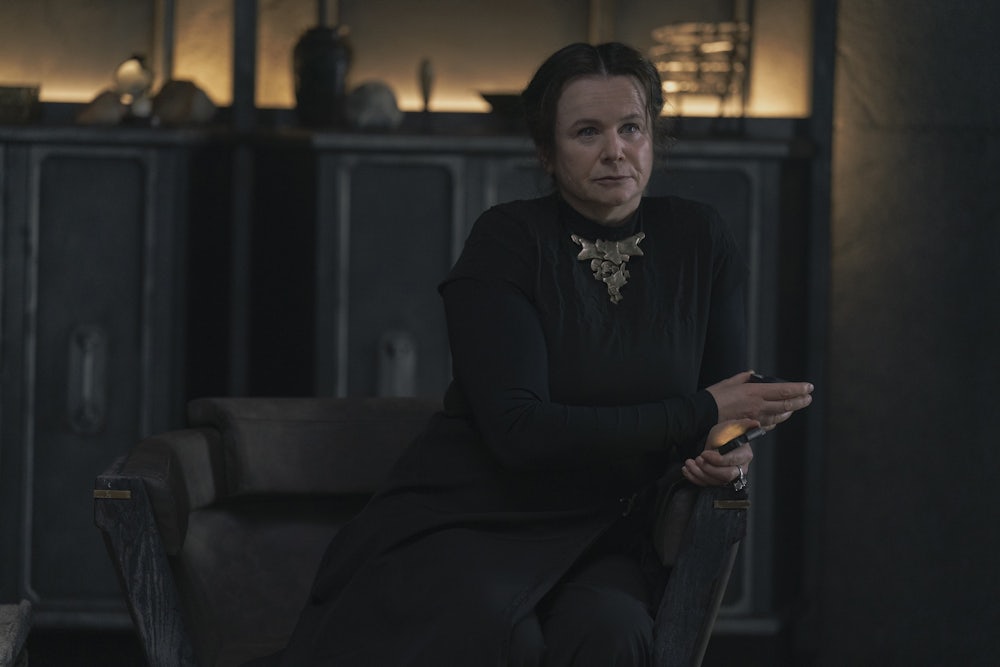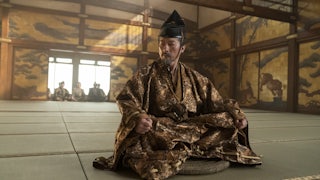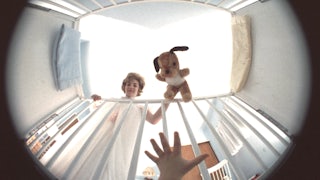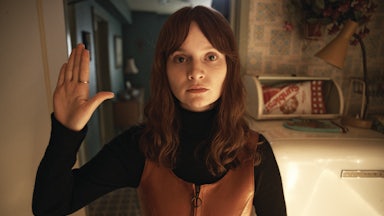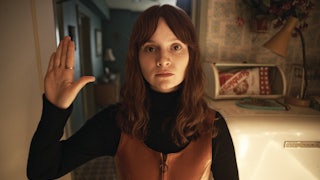Dune: Prophecy, the new HBO prequel series to the blockbuster film franchise, begins with one of the most hilariously hasty exposition-dump montages I’ve ever seen. Think of the great exemplars of this form: Cate Blanchett’s winding narration of Sauron’s rise and mankind’s near-fall at the beginning of The Fellowship of the Ring; Ray Liotta’s chatty memoir of his childhood life of crime at the beginning of Goodfellas; Linda Hamilton’s ominous fugue at the beginning of T2: Judgment Day. These sequences are fast-paced out of necessity, but they quickly develop their own compelling rhythm. There’s an art to conveying a bunch of information—some of it worthy of its own entire feature film or series—in a tight space. These sequences have to function as aesthetically consistent prologues or overtures rather than a series of narrative shortcuts designed to solve a problem.
Dune: Prophecy’s opening finds the series in immediate problem-solver mode, a fact especially striking considering that the prequel is set 10,000 years prior to the events of the films. If there’s so much to catch us up on this soon, you might be tempted to ask, why not go back a few more ticks? When you’re firing up the prequel machine, you can just punch whatever dates you want into the dashboard. Indeed, for viewers who know of this series only by way of its promotional material, the plot points that Emily Watson briskly narrates in this opening sequence are what I was led to believe this entire show was supposed to be about: the foundation and rise of the Bene Gesserit order of spooky space witches. Whoa whoa whoa, I thought, as Watson whizzed past the story of how the Imperium arose from the ashes of the “Machine Wars” that turned humanity against artificial intelligence. Hold up, I stuttered, as we are introduced to the Bene Gesserit’s mysterious founder only to scuttle her off to her death of old age a few seconds later. When one character uses “the voice” we know well for the first time, and she remarks to her shocked victim that it’s a new thing she’d been working on, I laughed out loud. If all of this spectacular lore merits barely more than a Wikipedia section’s worth of attention, I thought, we must be in store for some cavalcade of wonders once the show gets going. You’re setting expectations pretty high when you yada yada the robot apocalypse—even The Terminator knows that.
One of the narrative contrivances that allowed Denis Villeneuve to successfully adapt Dune, long characterized as an unadaptable novel, was that he transformed the story into a fairly straightforward tale of military brinkmanship. Consigning much of the novel’s complex strangeness—the Guild Navigators, the psychotropic logistics of Spice, etc.—to a kind of suffocating atmosphere of mysticism, Villeneuve was able to tell the novel’s story while tapping into that mythology on an as-needed basis. While this approach arguably made Villeneuve’s film less weird by degrees than its source material, it also made the film possible as a blockbuster phenomenon. And, to Villeneuve’s credit, the longer you spend in his Imperium, the more its oddity seeps in. That Sardaukar singing guy, the spider person in the Harkonnen lounge, one character is an unborn baby? The Lawrence of Arabia of it all serves as a Trojan horse for the trippiest space opera since Kubrick.
Dune: Prophecy tries a different way of making its source material manageable. Rather than follow a familiar plot structure in order to smuggle in some of most bananas material you can find in the multiplex, the creators of Dune: Prophecy have scoured the vast, unexplored universe to find its normiest nook. More to the point, the show clears out the weird stuff so it can discover the habitable zone of Frank Herbert’s universe where a bunch of Game of Thrones–style characters and plotlines might find breathable air. The show that follows is, despite this characterization, perfectly fine if your favorite parts of A Song of Ice and Fire happen in the Small Council chambers. There’s plenty of action, plenty of backstabbing, plenty of creepy-crawly little Frank Herbert doo-dads lying strewn around the place. But it’s hard not to wonder why HBO turned to their freakiest I.P. to make a show this familiar.
Another way of posing this question is to ask: Whither the spin-off? We are past the point where it’s at all a unique observation to say that the streaming landscape has been a fertile plain for reboots, sequels, prequels, and, in particular, spin-offs of already existing, already profitable, already beloved intellectual property. The spin-off, as a concept, shouldn’t necessarily signify a creative downgrade. Norman Lear was always spinning off his successful, acclaimed series into other successful, acclaimed series. Frasier was never the equal of Cheers, but it certainly shares a place in the pantheon of great sitcoms right alongside it. I’d even argue that Better Call Saul meaningfully improved upon its sire, Breaking Bad. But the biggest producers of spin-offs these days are not necessarily creators continuing to prod and explore the unexamined possibilities of their storyworlds so much as they are corporate executives ordering their most profitable content in greater volumes. The biggest culprits of this style of excessive development are the teeming cinematic universes—Marvel, DC, Star Wars. The returns on this particular style of brand management have been uneven at best, and some of the beloved brands themselves have risked a degree of fatigue. As Tina Fey once joked, “This is Hollywood, and if something kinda works they’ll just keep doing it until everybody hates it.”
But there have been a few successes even among the expanded universes. There are several species of spin-off, and whether a show rises or falls often depends more on what kind of spin-off it is. The easiest way to categorize is to name the particular relationship the spin-off series chooses to have to its source text. For instance, there’s the kind that lets us break off with a secondary character who’s either particularly beloved or seemingly worthy of a more complex storyline. This is very much the central guiding principle of lots of MCU TV. Loki, WandaVision, The Falcon and the Winter Soldier, Hawkeye, Ms. Marvel—these shows maintain sometimes tenuous, sometimes meaningful plot connections to the films, but, largely, they’re about building the universe through attention to supporting characters. Within the MCU, at least, these series also tend to have pretty distinctive stand-alone aesthetics or narrative gimmicks. They’re connected to the mothership by the character, but they feel formally different.
Then there are the spin-off series whose whole reason for being is that they don’t feel different. From a conceptual standpoint, if not from the standpoint of the makers themselves, the guiding principle of such series is for there simply to be more of the original. The Mandalorian, The Book of Boba Fett, and even Obi-Wan Kenobi fit this mold. Recently canceled Star Wars series The Acolyte was meant for this category too, but building out the world too much, and building it out in ways that implied some critique of the original franchise, was a step too far for Disney. For whatever its many charms and virtues, The Acolyte felt fundamentally like something else, and it was punished for that. The gold standard of this category, of course, is House of the Dragon, which turned back the clock on Game of Thrones just long enough for there to be a new set of Targaryens and Starks and for the storyworld to stock up on dragons. Sure, there are some nominal revisions to the original’s framing, but the main thing recommending House of the Dragon is that it quite simply feels like more Game of Thrones. Some of the breakout character series work on their own—WandaVision, in particular, benefited from some big metafictional risks paying off—but few of the More, Please spin-offs transcend, or even rival, the original material. They scratch an itch and don’t really do much more than that.
The best spin-offs in the current era—Agatha All Along and Andor—understand, to some extent, that sticking too close to the original is a fool’s errand. There are fewer series like this because spin-offs are definitionally low-risk, and because original shows like Agatha and Andor are definitionally risky. But when they sneak through, they can be special. They offer access to some breakout characters, for sure, and they offer more contact with the central beloved I.P., but they largely constitute their own universes. They could exist, truly without much trouble, without the mothership. Agatha All Along succeeded because its world was built so far outside of the MCU that it had to actually do some world-building. Kathryn Hahn is an electric performer—and most of the cast, from Aubrey Plaza to Patti Lupone, is working overtime to elevate every scene—but it would not work the same way if it were a series knitted too tightly into the narrative arc of whatever “Phase” MCU is in at the moment. The reason I know this is that the worst episode of the series, by a country mile, is the long episode dedicated to revealing one of the character’s surprising connections to the main MCU. Moving on from that episode felt like a relief; the show rejected all that lore like a foreign organ.
Andor took somewhat of an opposite tack, burrowing into the Star Wars universe, rather than traveling to its remote reaches. Taking, as its subject, the bureaucracy of the Empire, its power stations, its prisons, its infrastructure, its legislative power center, its slums, the areas of the galaxy populated by low-information voters, the fringes where rebels organize. Studiously avoiding any of the heroes or big bads, the show crafted its own aesthetic. They’re both series about the Galactic Empire the same way that Dog Day Afternoon and Night at the Museum are both movies about New York City.
It’s clear that Dune: Prophecy is trying quite hard to occupy this latter category. It travels 10,000 years into the past away from the events of Villeneuve’s films, it largely allows the sandworms to exist as a distant echo, and it trains its focus on the Bene Gesserit, an organization the films leave utterly mysterious and—deliberately—unexplored. So, at least on paper, Dune: Prophecy scampers far enough away from its source text to have a fighting chance; what it doesn’t really do is develop a perspective of its own.
After that initial sprint through the relevant backstory, Dune: Prophecy picks up with Mother Superior Valya Harkonnen (an austere and imperious Emily Watson), whose leadership over The Sisterhood—the order of women who train and dispatch “truth-sayers,” or human lie detectors, to the leaders of the Great Houses of the Imperium—is at a crisis point. When the former Mother Superior died, she vouchsafed a prophecy to Valya, that of a “burning truth” that would threaten the existence of the order. Valya is tasked with staying vigilant for whatever this sign might be, but also with protecting and advancing the Sisterhood’s most secret, most transformative project: the aristocratic breeding program that might eventually produce a great ruler of the Imperium, the leader we now know as Paul Atreides. That we are already aware that this process has to simmer for another 10 millennia or so tells us all we need to know about the ultimate stakes of Dune: Prophecy. The big prophecy isn’t coming true within the space of this series, so the show has the freedom to find its own way.
The strongest elements of the show are precisely the ones that take advantage of this freedom. Mark Strong’s portrayal of a weak and arrogant emperor easily manipulated by the last person he’s talked to introduces a destabilizing—and relevant!—dynamic. The glimpses we get into the day-to-day workings of the Sisterhood’s training facility are tantalizing, though not nearly enough. And Valya’s backstory, along with its somber tale of the Harkonnen family name—told largely through flashback in the third episode—is engrossing. But, apart from those few spots, most of what we encounter in Dune: Prophecy is palace intrigue we’ve already encountered in Westeros.
On its own terms, Dune: Prophecy is a fine show. It’s filled with excellent performances, dank but compelling production design, and intriguing little twists and turns. But it feels hemmed in by its status as a prequel, and the set of creative choices that entails. Years of spin-offs have taught us that studios are both eager to exploit their I.P. and jealously protective of it. They want to spread it as thin as can be, but they are loathe to do anything that would even remotely compromise their fan base’s rabid and unthinking attachment. Violations of this decorum—Rian Johnson’s Last Jedi, or, more recently, The Acolyte—are snuffed out immediately, contained and destroyed.
We know better, then, to expect a show to wholly reimagine its source, to stray far enough into the galaxy to feel genuinely new. Whether it’s the 10 millennia of imperial history with all the same names and all the same houses, or the 10 years of cinematic universe spin-off history, with all the same names and all the same houses, Dune: Prophecy feels old, even at its beginning.
